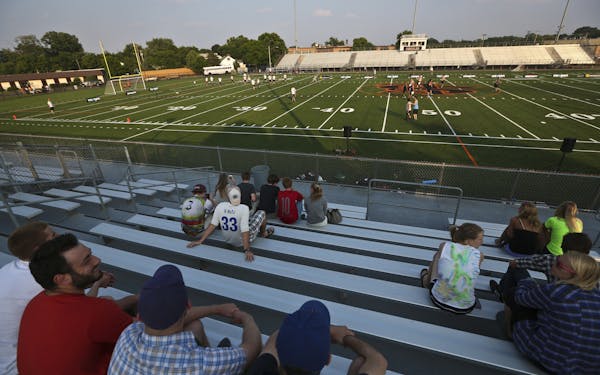The price tag for the future light-rail line between Minneapolis and the southwest suburbs will rise sharply — as much as 33 percent — under new estimates for the cost of dealing with conflicting freight train traffic.
The Southwest Corridor LRT, which was already expected to cost $1.25 billion, could reach nearly $1.7 billion if planners choose one of the options under consideration in the hotly contested area between Minneapolis and St. Louis Park.
Estimates released Wednesday put the lowest-cost option at $1.37 billion if the freight trains run alongside light-rail trains in the Kenilworth neighborhood of Minneapolis and bike and walking trails there were relocated. Similar options have been opposed by the city and could produce a lawsuit from homeowners.
Burying the LRT in a deep tunnel under the freight lines, and bike and walking paths in Kenilworth would satisfy many homeowners but could bring the highest cost: $1.67 billion.
Rerouting the freight from Minneapolis to berms in St. Louis Park would cost as much as $1.55 billion and draw opposition from that community.
The estimates were released by the Metropolitan Council, the agency overseeing the light-rail project, and will add more fuel to an already heated debate over the LRT and freight traffic.
The cost of dealing with the freight will likely make the Southwest Corridor light-rail line the most expensive public works project in the Twin Cities.
The head of transit development for the agency, Mark Fuhrmann, said Wednesday he isn't surprised by the cost of dealing with the freight.
"Designing and building rail … is pricey," he said. "It just comes with the territory."
Costs rise for state, counties
The cost estimates also will put more of a burden on county governments and the state, which are expected to fund 50 percent of project. The federal government is expected to pick up the other half.
"We knew the resolution of the freight issue was going to cost them money," said Hennepin County Commissioner Peter McLaughlin. "These are significant … no question about it."
The estimates also are likely to increase resistance among some Republican legislators to fund the state's share of the costs.
Minneapolis and St. Louis Park have been at odds over what to do with the freight rail that currently runs through Kenilworth. The Minneapolis City Council endorsed the light-rail line running through the Kenilworth corridor between Cedar Lake and Lake of the Isles, an area popular with bikers and hikers, but only on condition that the freight be relocated.
St. Louis Park residents have objected to taking on additional freight traffic and to berms as high as two stories where new tracks would be put. Their City Council prefers keeping the freight in some fashion in Kenilworth.
Meanwhile, a group of Kenilworth residents prefers living with the infrequent freight traffic rather than having the more frequent LRT trains running above ground. They back the deep tunnel for the LRT and running the freight and biking and hiking trails above it.
While those residents said a deep tunnel might cost $100 million, the Met Council Wednesday estimated its cost as high as $420 million, which includes $85 million to $90 million in bridges and other freight elements common to all of the options.
Other tunnel options
Another option involves building less expensive, shallower light-rail tunnels in Kenilworth. One would add as much as $250 million to the $1.25 billion project, while a shorter version on the south end of Kenilworth would add $180 million to $190 million.
Relocating the freight to St. Louis Park would add up to $300 million to the project and require acquiring 32 to 46 homes, businesses and other properties.
The least expensive alternative adds at least $120 million to the project but forgoes tunnels and berms and would run the freight and LRT next to each other in Kenilworth while relocating the bike and walking trails. Another option keeps the freight, LRT and recreational trails at ground level and alongside each other in Kenilworth and would add perhaps $145 million to the $1.25 billion cost. That option would mean acquiring about two-dozen residential properties.
But options for having the freight and LRT next to each other at ground level are similar to an option already rejected by Minneapolis. "That will definitely lead to a battle," said Michael Wilson, a nearby resident.
St. Louis Park residents saw the cost estimates as confirming their view that rerouting freight traffic into their community is "cost prohibitive," said Thom Miller, an organizer of opponents there. "They're very close to where we estimated them," he said of building berms.
About 300 people packed a meeting room near Cedar Lake Wednesday evening to hear Met Council engineer Jim Alexander present the different freight options and their cost.
Among them was Tom Johnson, an attorney representing Kenilworth homeowners who prefer a deep tunnel.
"I'm curious why the deep tunnel is so much higher" than earlier estimates from proponents, he said.
Pat Doyle • 612-673-4504

Minnesota State Patrol celebrates diverse new class of troopers

Fired Mpls. teacher accuses management of 'cancerous rot'

Jill Biden rallies women, teachers for the Biden-Harris ticket in Bloomington speeches
Neighbors, city officials at odds over Rochester lake dam

